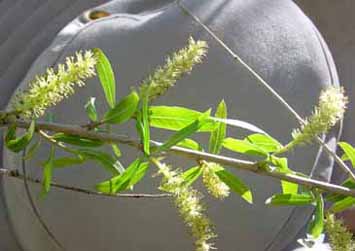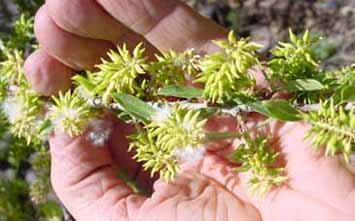
Goodding (Black) Willow (Salix gooddingii)
Main sources: Petrides, George & Olivia Petrides, 1992, A Field Guide to Western Trees, pp. 66-70, Houghton-Mifflin; Zimmerman, Robert, 1969, Plant Ecology of an Arid Basin Tres Alamos-Redington Area Southeastern Arizona, Geological Survey Professional Paper 485-D, Washington, D.C.
Goodding Willow is a dominant species in many riparian communities of the Southwest, where it is often co-dominant with the Fremont Cottonwood. Like the cottonwoods, willows are confined to places where fresh water is near the surface. Our willows are easily recognized by their long, narrow lanceolate leaves (which are alternate and simple) -- 8 to 15 times as long as they are wide -- and 2 to 6" long. The leaves of the Goodding are green on both sides. The banner photo above, taken June 07 2003, shows the mature leaves.
Willows are dioecious --male and female flowers (in catkins) are on different plants. Below left: male flowers, Hot Springs Canyon, March 2003; below right, female flowers, Hot Springs Canyon, April 2003: (Click on each image to enlarge it)
Here, below, are very new leaves and catkins sprouting on a large Goodding Willow near the Teran Wash confluence with the San Pedro River, on March 12, 2005. Note that some of these leaves are much blunter than the more sharply pointed and lanceolate mature ones: (Click on the image to enlarge it)
Below, the bark of the mature tree from whose limbs the above photo was taken. The young leaves and catkins can also be seen in this image.

Click here for more images of leaves, flowers, bark etc.
Return to Trees & Shrubs


